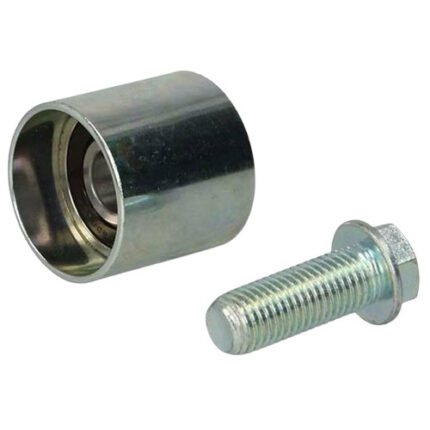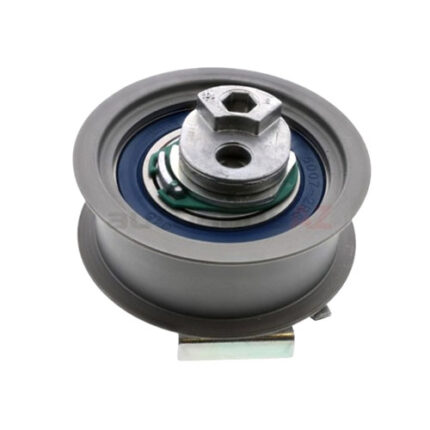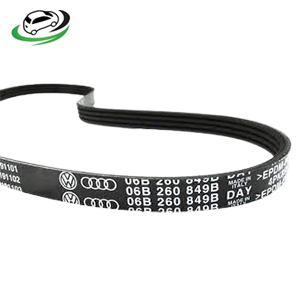Get A/C Drive Belt AUDI B5 A4 1.8T / BMW E36 M42 1.8L / VW Passat B5 1.8T/TDI 06B260849A
The A/C drive belt, also known as the air conditioning drive belt or serpentine belt, is a key component in a vehicle’s accessory drive system. It plays a crucial role in powering various accessories, including the air conditioning (A/C) compressor. Here’s a detailed yet straightforward explanation of what it is, how it works, and why it’s important.
What is the A/C Drive Belt?
The A/C drive belt is a flexible, rubberized belt that connects the engine’s crankshaft pulley to various accessories, including the A/C compressor. It is often part of a serpentine belt system, which also drives other components such as the alternator, power steering pump, and water pump. In some vehicles, the A/C drive belt may be a separate belt specifically for the air conditioning system.
How Does the A/C Drive Belt Work?
Here’s how the A/C drive belt functions:
- Power Transfer: The A/C drive belt transfers rotational power from the engine’s crankshaft to the A/C compressor. The crankshaft pulley, which is connected to the engine, drives the belt, which in turn drives the A/C compressor pulley.
- Engaging the A/C Compressor: When the A/C system is activated, the A/C compressor engages and starts to compress the refrigerant. The drive belt ensures that the compressor receives the necessary power to perform this function.
- Maintaining Tension: The drive belt must be properly tensioned to ensure it effectively powers the A/C compressor and other accessories. Some systems use an automatic tensioner to maintain the correct belt tension.
- Supporting Multiple Accessories: In a serpentine belt system, the A/C drive belt is responsible for powering multiple accessories, not just the A/C compressor. It wraps around several pulleys and helps drive the alternator, power steering pump, and water pump.
Why is the A/C Drive Belt Important?
The A/C drive belt is essential for several reasons:
- Operates the A/C System: The primary function of the A/C drive belt is to power the A/C compressor. Without a functioning belt, the air conditioning system cannot operate, leading to a lack of cool air in the vehicle.
- Powers Other Accessories: In a serpentine belt system, the drive belt also powers other critical components, such as the alternator and power steering pump. A failure of the belt can affect multiple systems in the vehicle.
- Ensures Proper Engine Operation: The drive belt helps ensure that accessories are operating correctly, which contributes to overall engine performance and reliability. Properly functioning accessories are important for vehicle comfort and safety.
- Prevents Component Wear: A properly tensioned and functioning drive belt helps prevent excessive wear and tear on the A/C compressor and other accessories. This helps extend the lifespan of these components.
Signs of a Failing A/C Drive Belt
A failing A/C drive belt can lead to various issues. Here are some common signs that the belt may be failing:
- Squealing or Chirping Noise: A worn or loose A/C drive belt may produce squealing or chirping noises, especially when the engine is running. These noises can indicate that the belt is slipping or not properly tensioned.
- Loss of A/C Performance: If the A/C system is not cooling effectively or if the compressor is not engaging, it could be due to a problem with the drive belt. The belt may not be providing enough power to the compressor.
- Visible Wear or Damage: Inspecting the drive belt may reveal visible signs of wear or damage, such as cracks, fraying, or glazing. These issues can affect the belt’s performance and lead to failure.
- Engine Accessory Malfunctions: If other accessories driven by the same belt, such as the alternator or power steering pump, are malfunctioning, it could indicate a problem with the drive belt.
- Belt Slippage: If the belt is slipping or appears loose, it may not be able to power the A/C compressor and other accessories effectively. This can lead to reduced performance and potential damage.
Maintaining the A/C Drive Belt
Proper maintenance of the A/C drive belt involves several key practices:
- Regular Inspections: Periodically inspect the A/C drive belt for signs of wear, damage, or misalignment. Regular inspections can help identify potential issues before they lead to more significant problems.
- Check Tension: Ensure that the drive belt has the correct tension. Most vehicles have an automatic tensioner that maintains proper tension, but it’s important to check that it is functioning correctly.
- Replace Worn or Damaged Belts: If the drive belt shows signs of significant wear or damage, replace it promptly. This helps prevent further issues with the A/C system and other accessories.
- Listen for Noises: Pay attention to any unusual noises coming from the engine, such as squealing or chirping. These sounds can indicate a problem with the drive belt that may need attention.
- Follow Manufacturer’s Recommendations: Adhere to the vehicle manufacturer’s recommended maintenance schedule for the drive belt and associated components. This helps ensure that the belt and related parts are replaced at the appropriate intervals.
Replacing the A/C Drive Belt
If the A/C drive belt fails or shows signs of significant wear, it’s important to replace it. Here’s a general guide to the replacement process:
- Preparation: Gather the necessary tools and a new A/C drive belt. Ensure the engine is cool and secure the vehicle on a flat surface.
- Locate the Belt: Identify the A/C drive belt and the pulleys it connects. The belt is typically located at the front of the engine and is driven by the crankshaft pulley.
- Release Tension: If the vehicle has an automatic tensioner, use a wrench or tool to release the tension on the belt. This will allow you to remove the old belt. Some systems may have a manual tensioner or adjustment that needs to be loosened.
- Remove the Old Belt: Carefully remove the old A/C drive belt from the pulleys. Take note of the belt’s routing, as you will need to install the new belt in the same configuration.
- Install the New Belt: Position the new A/C drive belt around the pulleys, following the correct routing. Ensure that it is properly aligned with the pulleys and that it is seated correctly.
- Reapply Tension: Reapply tension to the new belt using the tensioner or adjustment mechanism. Ensure that the belt has the correct amount of tension and is properly aligned with the pulleys.
- Check Operation: Start the engine and check the A/C system to ensure that the new belt is functioning correctly. Listen for any unusual noises and ensure that the A/C compressor engages properly.
- Follow us on Facebook for more parts.



